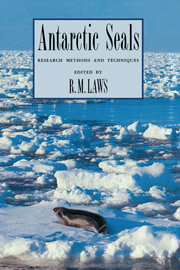Book contents
- Frontmatter
- Contents
- List of contributors
- Preface
- Introduction
- 1 Identification of species
- 2 Estimation of population sizes
- 3 Immobilization and capture
- 4 Marking techniques
- 5 Telemetry and electronic technology
- 6 Behaviour
- 7 Killing methods
- 8 Morphometrics, specimen collection and preservation
- 9 Genetic-based studies for stock separation
- 10 Collection of material for the determination of organochlorine and heavy metal levels
- 11 Age determination
- 12 Reproduction
- 13 Diet
- 14 Bioenergetics
- 15 Development of technology and research needs
- 16 Appendices
- Index
3 - Immobilization and capture
Published online by Cambridge University Press: 05 February 2010
- Frontmatter
- Contents
- List of contributors
- Preface
- Introduction
- 1 Identification of species
- 2 Estimation of population sizes
- 3 Immobilization and capture
- 4 Marking techniques
- 5 Telemetry and electronic technology
- 6 Behaviour
- 7 Killing methods
- 8 Morphometrics, specimen collection and preservation
- 9 Genetic-based studies for stock separation
- 10 Collection of material for the determination of organochlorine and heavy metal levels
- 11 Age determination
- 12 Reproduction
- 13 Diet
- 14 Bioenergetics
- 15 Development of technology and research needs
- 16 Appendices
- Index
Summary
Introduction
Studies of wild animals often require the capture and immobilization of representative specimens for such purposes as making accurate body measurements, determination of sex and age, collecting of blood or milk samples, or attaching recorders and transmitters. Although great progress has been made in the development of techniques for the capture and immobilization of terrestrial animals using drugs, their use on seals is still in the experimental stage and further work is needed before definitive recommendations can be made for most species.
The use of drugs for the field anaesthetizing of wild animals is considerably more difficult than working with animals in the laboratory or in normal animal practice where information usually exists on the history of the subjects and where greater support facilities and expertise are normally available. Characteristically, the field researcher is faced with the problem of having to immobilize free-ranging animals in difficult situations and often under adverse conditions. The researcher is further required to estimate the body size and physiological state of the animal to be immobilized in order to approximate dosage rates, and not infrequently must proceed without knowledge of the physiological effect of the various drugs on a particular species.
Investigators should also be aware that the distribution or availability of some immobilizing drugs may be restricted so that they are not generally available. Sufficient lead time should be allowed to obtain such things as permits. (See Appendix 16.7.)
- Type
- Chapter
- Information
- Antarctic SealsResearch Methods and Techniques, pp. 46 - 88Publisher: Cambridge University PressPrint publication year: 1993
- 8
- Cited by



